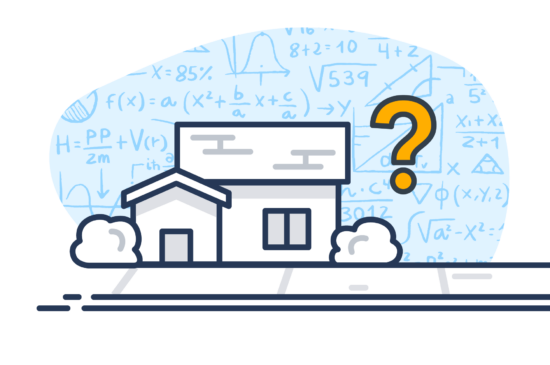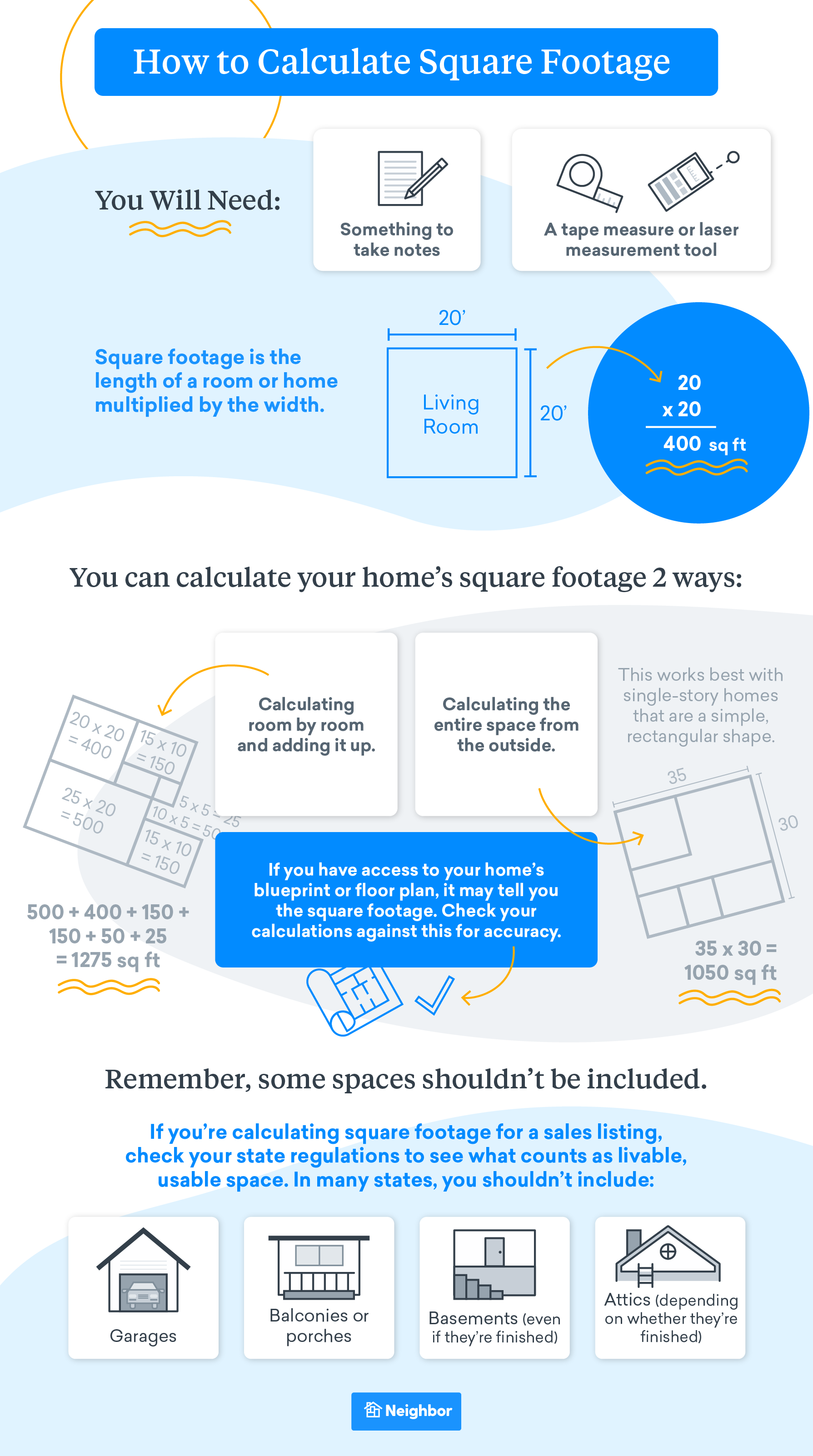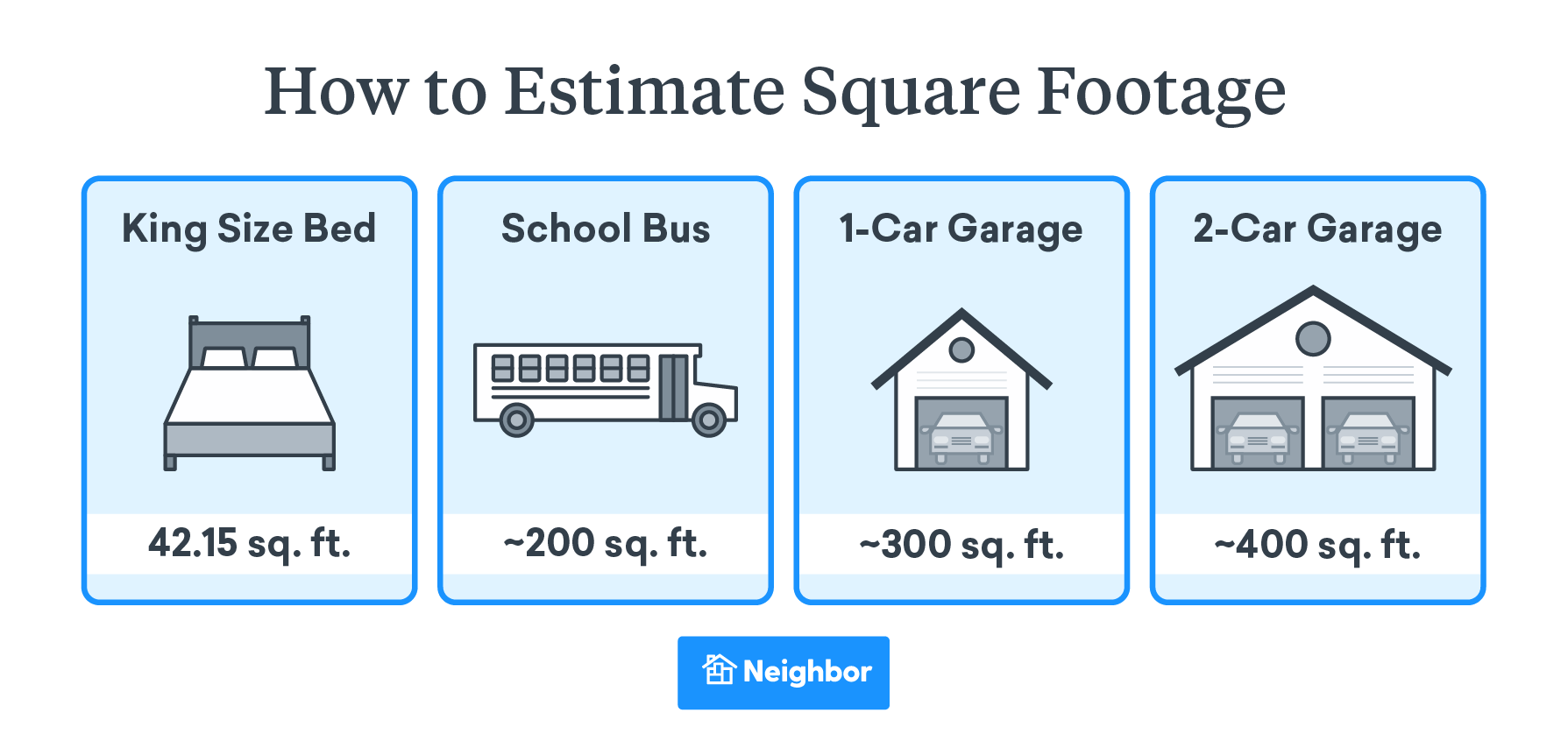Do you know your home’s exact square footage?
If you don’t, you’re far from alone. While square footage is one of the most important data points to know about a home, there’s a lot of confusion about how to measure it. And first-hand accounts from homebuyers tell us you can’t necessarily trust the square footage that’s claimed on a home listing.
This ultimate guide is one that every homeowner and renter needs. Here’s what we’ll cover below:
How to calculate square footage
The importance of knowing square footage
Free square footage calculator
How to estimate square footage
How to determine how much square footage you need
How to calculate square footage
Calculating square footage is, luckily, pretty simple. You just multiply the length of a room or house in feet by the width in feet.
The basic formula for square feet:
Length x Width = total area square footage
Unfortunately, that equation only applies to rooms and homes that are rectangular or square. If your home has any odd-shaped rooms, things get a lot more complicated.
It seems like a straightforward question: How do you calculate square footage in your home?
Unfortunately, the answer isn’t as straightforward as you’d think. For different purposes (like sale listings) states regulate what parts of a home should be measured, and what parts shouldn’t. Here’s what you need to know.
The below methods and tips will work well if you have all or mostly rectangular rooms. If you have any more complex spaces and you aren’t particularly skilled in math, we recommend leaving the square footage calculation to an expert (like an appraiser), or consulting your home’s floor plan.
Tools needed to measure square footage
There are a few different ways you can measure your square footage.
- Something to take notes (either a pen and paper, or a phone or other device with a notepad app);
- A tape measure or laser measuring tool.
The importance of knowing square footage
What’s the big deal about square footage, anyway? Why is it so hard to calculate — and so important to know?
Square footage is a necessary piece of data for determining a number of things about your home and your family’s needs. These are just some of the reasons it’s so important to know and understand square footage.
Home value and price per square foot
First and foremost, square footage is a major factor in determining your home’s value. Generally, when appraising a home, professionals will first calculate the exact square footage, and then compare your home to other homes in the same area with a comparable amount of living space.
They’ll make adjustments based on factors like your home’s age, materials, and finishes — but square footage is the single most important factor (and the first step) in setting a value or sale price for your home. Additionally, being familiar with the price per square foot for your home and similar, nearby listings can give you a point of reference for comparing different properties when shopping for a home.
This is also one of the reasons it’s so important to get an accurate measurement of your home’s square footage — if it’s measured incorrectly, that can have a domino effect that throws off your home’s value, sale price, and more.
Home renovation costs
If you ever make any major updates to your home — for example, renovating your kitchen or finishing your basement — you’ll likely need to know the exact square footage in order to get building permits.
Knowing the exact square footage of a space you’re renovating is also helpful when it comes to making cost estimations and setting a budget for the project. Different areas, like kitchens, bathrooms, and basements, have different average costs per square foot to renovate, so familiarizing yourself with these can help you set a realistic budget for making over your own space.
Property taxes
Since square footage is such an important factor in your home’s value, it’s also a big part of determining your yearly property taxes, which are based on the assessed value of the home and property. If your square footage is improperly calculated, it could result in you over- or under-paying on your taxes.
Additionally, if you work from home, knowing your home’s square footage can help provide tax benefits — you may be able to write off a portion of your rent or mortgage payments and utilities based on the square footage of a home office or work area.
Knowing your (and your family’s) needs
Finally, knowing and understanding square footage can help you better understand exactly what your family needs when looking for a home. We’ll get into this in more detail below, but it’s always a good idea to know how much square footage your family needs to live and function comfortably.
Free square footage calculator
Need help calculating your square footage? The calculator below can help (and, optionally, you can estimate home values if you know the average cost per square foot in your area).
Additional tips for calculating square footage
These tips will make calculating and estimating square footage even easier.
Measure room by room
One simple way to calculate your home’s square footage is by measuring each room, calculating its square footage, and then adding all your totals together. This method works well if all your rooms and spaces are rectangular, keeping the calculations fairly simple.
Measure the outside of the house
Alternatively, if your home is just one story and rectangular shaped, you can calculate the square footage of the entire home in one equation by measuring outside. Measure the length and width of the entire home and multiply them to determine your total square footage.
Double check against your home’s floor plan
If you have access to your home’s blueprint or floor plan, it may tell you the square footage. It’s a good idea to check your calculations against the dimensions on the floor plan for accuracy.
Refer to regulations and guidelines
You shouldn’t necessarily include every space in your home in your square footage calculations. For example, if you have a multi-story home with a foyer that’s two-stories high, you wouldn’t be able to calculate the square footage on the ground floor and then just double it — the foyer square footage would need to be subtracted from the second-story total.
Additionally, the American National Standards Institute provides guidelines for measuring home square footage, which is typically what governments use to assess property taxes, and what most realtors use for home listings. According to those guidelines, you shouldn’t include certain spaces in your square footage calculations:
- Garages;
- Balconies;
- Porches;
- Basements, even if they’re finished;
- Attics if they’re unfinished, not insulated, or have low ceilings.
These are all just guidelines, though. No one enforces them, which is why it’s so important to do your own calculations to ensure you have an accurate square footage measurement for your own home and any home you’re considering buying or renting.
For an exact square footage measurement, hire a professional
If you want to be really sure you’re accurate in measuring your home’s square footage, there are experts for that: appraisers. Hiring one means they’ll take an ultra-accurate measurement of your square footage, while also considering other factors about your home, to place a potential sales value on it. It’s common to have a home appraised before you sell it, but you can actually do it at any time.
How to quickly estimate square footage
Sometimes, you might need to estimate or visualize square footage without being able to measure it exactly. This is an especially useful skill if you’re shopping for a home or apartment. Here are some tips, tricks, and examples for making square footage estimates in the real world.
Use your body
One way to get a rough estimate of the width and length of a space is by using your own body. Measure body lengths to use your height. Or measure the length of your foot and walk heel-to-toe to measure the distance. You can also measure the length of your stride, but this will result in a less accurate measurement, since it will vary a little bit with each step.
Use tiles
If the room you’re trying to estimate has tiles on the floor, you can use them to get an estimate of the square footage by assuming that each tile will be around one square foot. Remember that tiles can be larger or smaller than this, though, so your accuracy may vary with this method depending on how close the tiles are to 12 inches.
Visualize comparative spaces
If you don’t need an exact number, but just a rough guess of the square footage of a space, you can compare it to items or other spaces you might be familiar with. For example,
- A king size bed is 42.15 square feet.
- The inside of a school bus is about 300 square feet.
- A one-car garage is about 200 square feet, while a two-car garage will be around 400 square feet.
How much square footage do you need?
Now for the reason many families set out to learn about square footage in the first place: To find out how much of it they need.
Census Bureau statistics say that overall, newly constructed homes are getting bigger and bigger. But at the same time, minimalist living remains popular, and tiny homes are a trend that isn’t slowing down.
At the end of the day, it’s subjective. There’s no simple rule that will tell you exactly the right size home for your family. But here are some guidelines to help you begin to figure out how much space your family needs in a home.
- Start with your existing square footage. First, calculate an accurate square footage for your existing home so you have a starting point. Then, sit down (with your family, if you’d like), and think about whether your current home is too small, too big, or just right for you. Depending on what you decide, you should have a better idea of the kind of square footage you should look for in your next home.
- Consider your family’s needs. How big is your family? Do you need a home office? Do you often have friends or family visiting who need a guest room where they can spend the night? These questions will also help you figure out what kind of square footage you need — the bigger your family and the more spaces you need, the more square footage you’re likely to want for your home.
- Think about your furniture. In some cases, your possessions will be a factor in how much square footage you need. For example, if you have a king sized bed set, you’ll need a home with at least one large bedroom to accommodate it. Same thing if you have a large sectional couch, an eight-person dining set, or a pool table.
- Maintain the right ratio. According to some experts, for every bedroom in your home, you should have the space to seat two people in the dining room and living room. Keep that ratio in mind as you look at homes — you don’t want to end up with a bedroom for everyone, but no room for the family in common spaces.
- Remember how much difference a good layout can make. For example, a 2,500 square foot home with each room closed off will seem smaller than a 2,200 square foot home with an open concept floor plan. Keep this in mind, and don’t be too set on one specific number — there’s no such thing as the “perfect” square footage for any family; just a home that allows you to happily function.
Turn extra square footage into income with Neighbor
Do you have a little more square footage than you (or your family) need?
You can help out a neighbor and earn some extra income on the side by renting out a closet, a room, an attic, or another unused space with Neighbor.
Neighbor connects people with extra space with people who need safe, secure storage for extra belongings. In the process, we’re bringing people and neighborhoods closer together.
Ready to use your spare square footage to help out a neighbor? List your space today.
Browse all our helpful storage guides:
- Storage Unit Size Guide
- Average Monthly Storage Unit Costs
- Types of Storage Units
- Storage Unit Insurance Guide
- How to Calculate Square Footage










